
Santa Maria in Palmis, also known as Chiesa del Domine Quo Vadis, is a small church southeast of Rome. It is located about some 800 m from Porta San Sebastiano, where the Via Ardeatina branches off the Appian Way, on the site where, according to the apocryphal Acts of Peter, Saint Peter met the risen Christ while Petrus was fleeing persecution in Rome. According to the tradition, Peter asked him, "Lord, where are you going?". Christ answered, "I am going to Rome to be crucified again".
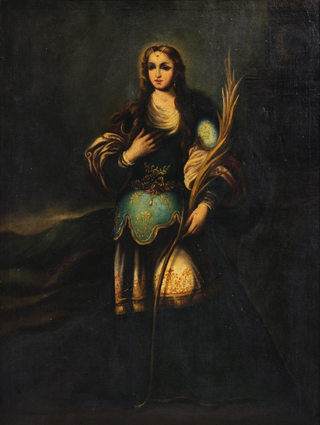
Philomena, also known as Saint Philomena or Philomena of Rome was a young virgin martyr whose remains were discovered on May 24–25, 1802, in the Catacomb of Priscilla. Three tiles enclosing the tomb bore an inscription, Pax Tecum Filumena, that was taken to indicate that her name was Filumena, the English form of which is Philomena. Philomena is the patron saint of infants, babies, and youth, and is known as "The Wonderworker".

The Catacombs of Rome are ancient catacombs, underground burial places in and around Rome, of which there are at least forty, some rediscovered only in recent decades. Though most famous for Christian burials, either in separate catacombs or mixed together, Jews and also adherents of a variety of pagan Roman religions were buried in catacombs, beginning in the 2nd century AD, occasioned by the ancient Roman ban on burials within a city, and also as a response to overcrowding and shortage of land. The most extensive and perhaps the best known is the Christian Catacomb of Callixtus located near the Park of the Caffarella, but there are other sites, both Christian and not, scattered around the city, some of which are now engulfed by modern urban sprawl.
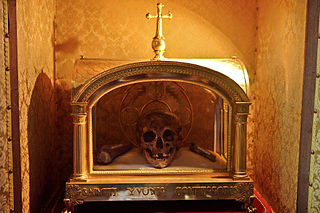
In religion, a relic is an object or article of religious significance from the past. It usually consists of the physical remains or personal effects of a saint or other person preserved for the purpose of veneration as a tangible memorial. Relics are an important aspect of some forms of Buddhism, Christianity, Islam, shamanism, and many other religions. Relic derives from the Latin reliquiae, meaning "remains", and a form of the Latin verb relinquere, to "leave behind, or abandon". A reliquary is a shrine that houses one or more religious relics.
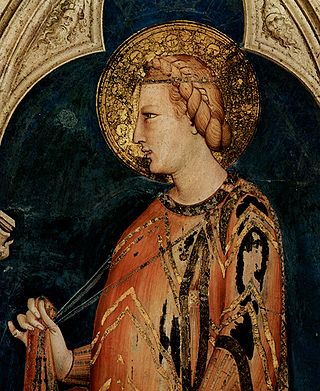
Elizabeth of Hungary, also known as Saint Elizabeth of Thuringia, or Saint Elisabeth of Thuringia, was a princess of the Kingdom of Hungary and the landgravine of Thuringia in Germany.

Ursula is a legendary Romano-British Christian saint. Her feast day in the pre-1970 Calendarium Romanum Generale is 21 October. There is little information about her and the anonymous group of holy virgins who accompanied and, on an uncertain date, were killed along with her at Cologne. They remain in the Roman Martyrology, although their commemoration does not appear in the simplified General Roman Calendar of the 1970 Missale Romanum.

Saint Peter's tomb is a site under St. Peter's Basilica that includes several graves and a structure said by Vatican authorities to have been built to memorialize the location of Saint Peter's grave. St. Peter's tomb is alleged near the west end of a complex of mausoleums, the Vatican Necropolis, that date between about AD 130 and AD 300. The complex was partially torn down and filled with earth to provide a foundation for the building of the first St. Peter's Basilica during the reign of Constantine I in about AD 330. Though many bones have been found at the site of the 2nd-century shrine, as the result of two campaigns of archaeological excavation, Pope Pius XII stated in December 1950 that none could be confirmed to be Saint Peter's with absolute certainty. Following the discovery of bones that had been transferred from a second tomb under the monument, on June 26, 1968, Pope Paul VI said that the relics of Saint Peter had been identified in a manner considered convincing. Only circumstantial evidence was provided to support the claim.

Pancras was a Roman citizen who converted to Christianity and was beheaded for his faith at the age of fourteen, around the year 304. His name is Greek (Πανκράτιος) and means "the one that holds everything".

Vahni Anthony Ezekiel Capildeo is a Trinidad and Tobago-born British writer, and a member of the extended Capildeo family that has produced notable Trinidadian politicians and writers.
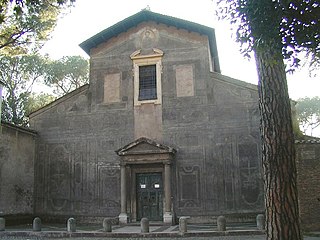
Santi Nereo ed Achilleo is a fourth-century basilica church in Rome, Italy, located in via delle Terme di Caracalla in the rione Celio facing the main entrance to the Baths of Caracalla. It has been the titular church of Cardinal Celestino Aós Braco since 28 November 2020.

Nereus and Achilleus are two Roman martyr saints. In the present General Roman Calendar, revised in 1969, Nereus and Achilleus (together) are celebrated on 12 May.

Petronilla is an early Christian saint. She is venerated as a virgin by the Catholic Church. She died in Rome at the end of the 1st century, or possibly in the 3rd century.

Santi Marcellino e Pietro al Laterano is a Roman catholic parish and titular church in Rome on the Via Merulana. One of the oldest churches in Rome, it is dedicated to Saints Marcellinus and Peter, 4th century Roman martyrs, whose relics were brought here in 1256.

Eustorgius I was bishop of Milan from 343 to about 349. He is honoured as a Saint in both the Catholic Church and the Eastern Orthodox Church. His feast day is on the September 18.

Saints Marcellinus and Peter are venerated within the Catholic Church as martyrs who were beheaded. Hagiographies place them in 4th century Rome. They are generally represented as men in middle age, with tonsures and palms of martyrdom; sometimes they hold a crown each.
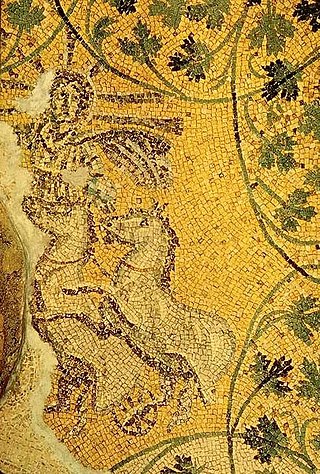
The Vatican Necropolis lies under the Vatican City, at depths varying between 5–12 metres below Saint Peter's Basilica. The Vatican sponsored archaeological excavations under Saint Peter's in the years 1940–1949 which revealed parts of a necropolis dating to Imperial times. The work was undertaken at the request of Pope Pius XI who wished to be buried as close as possible to Peter the Apostle. It is also home to the Tomb of the Julii, which has been dated to the third or fourth century. The necropolis was not originally one of the Catacombs of Rome, but an open-air cemetery with tombs and mausolea.

The Catacomb(s) of Callixtus is one of the Catacombs of Rome on the Appian Way, most notable for containing the Crypt of the Popes, which once contained the tombs of several popes from the 2nd to 4th centuries.
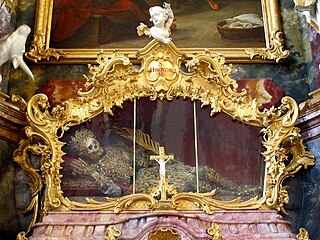
Hyacinth was a young Christian living at the start of the second century, who is honored as a martyr and a saint by both the Eastern Orthodox Church and the Roman Catholic Church. Hyacinth is sometimes called by his Latin name Hyacinthus.

Catacomb saints were the bodies of ancient Christians that were carefully exhumed from the catacombs of Rome and sent abroad to serve as relics of certain saints from the 16th century to the 19th century. They were typically lavishly decorated with gold and precious stones.

The Catacombs of San Sebastiano are a hypogeum cemetery in Rome, Italy, rising along Via Appia Antica, in the Ardeatino Quarter. It is one of the very few Christian burial places that has always been accessible. The first of the former four floors is now almost completely destroyed.




















